These pages can be called vexillology pages in the same way my conlang pages can be called linguistics pages. I am intensely interested in history, and, being a worrier by nature, I am always asking the question, "What if...?" Along with my languages, I have created an alternate history, a Uchronia if you will, that could have unfolded had the Germanic king Odoacre not been killed in battle. Such a change would not have allowed Justinian to take the throne and Europe would have evolved under Germanic influence, not Roman.
A technical note, if you will: each of the flags can be clicked on in order to see a larger picture of the flag.
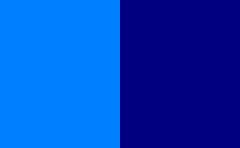 My interest in flags is as old as my interest in languages and history, but perhaps not quite so passionate. I do, though, feel that it is only right ( :) ) for my uchronia people to represent themselves. The first flag I seriously designed was in 1999 and it stood to represent the Cepperjoleddic language (pictured at the left). The flag was simple: the traditional Cepper colors - blue on blue - with St Andrew's Cross in the canton in homage to Gaelic, to which the language owed many loans. Today, I represent the old Ceppers and Cepperjoleddic language communities with the Old Cepper Flag (pictured at the right). The Cepper people were the descendents of the Gaels and Gothic peoples who settled Thula Island (Iceland). To represent their watery way of life, and their dual-heritage, the Ceppers use a blue-on-blue bicolor. In the Anglo-Saxon conquest (late AD 800s), the Cepper flag splattered with blood was such a common sight that the conquest is called the Purple Wars.
My interest in flags is as old as my interest in languages and history, but perhaps not quite so passionate. I do, though, feel that it is only right ( :) ) for my uchronia people to represent themselves. The first flag I seriously designed was in 1999 and it stood to represent the Cepperjoleddic language (pictured at the left). The flag was simple: the traditional Cepper colors - blue on blue - with St Andrew's Cross in the canton in homage to Gaelic, to which the language owed many loans. Today, I represent the old Ceppers and Cepperjoleddic language communities with the Old Cepper Flag (pictured at the right). The Cepper people were the descendents of the Gaels and Gothic peoples who settled Thula Island (Iceland). To represent their watery way of life, and their dual-heritage, the Ceppers use a blue-on-blue bicolor. In the Anglo-Saxon conquest (late AD 800s), the Cepper flag splattered with blood was such a common sight that the conquest is called the Purple Wars.
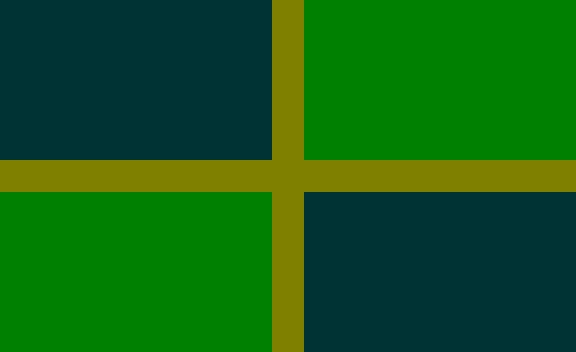
Sjönne's flag |
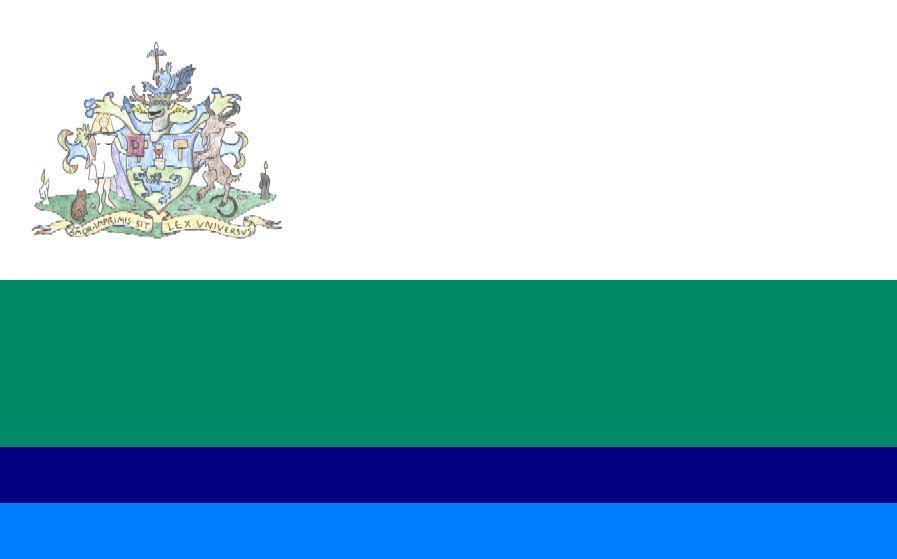
Zykkæ's flag |
The Thiazic Confederation was a loose coalition of Germanic and Thiazic monarchies that spanned from the south of Spain to the northernmost point in Norway. In 1347, they were united and became one great empire under the leadership of Father Sjönne I. Sjönne designed for his country a flag based on the traditional green of the Thiazic and Germanic peoples. In 1447, on the centennial anniversary of the country, the nation sundered in civil war. The northernmost states, the Thiazic states, sought alliance with the Ceppers under Father Zykkæ I. With the Ceppers help, they launched war on the southernly Germanic tribes who were far less organized. Zykkæ rode into battle carrying a flag that sported both the Thiazic green and white and the the Cepper blues. In the canton space was his coat of arms. The Thiazic flag is now the oldest national flag in use. It has been unchanged since 1447. Father Zykkæ's still adorn the upper left corner in honor of the man who made the Thiazics great. Please also note that Thiazic green is far lighter than Germanic green, which borders on black.
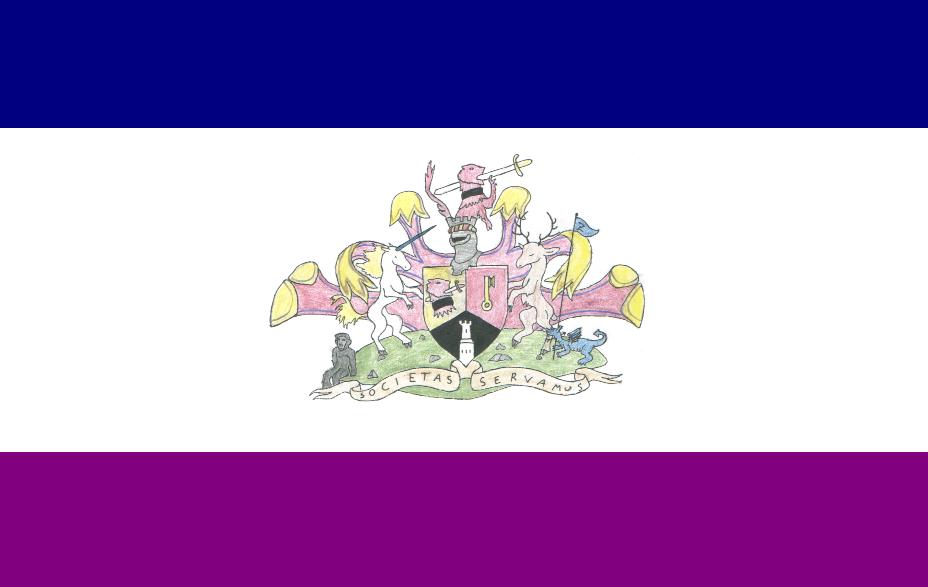 The decendents of the Vandals called themselves the Tetlo, which through the years and through dissimilation became Peto. With shellfish they dyed their flags with a deep purple stripe and the Peto flags also bore the Peto coat of arms. They met the Germanic Confederation on the battlefield on the islands around Southern Italy in the late 17th century. The Germanic Confederation did not stand a chance against the strong and skilled African warriors. The Thiazic Confederation was forced into a glooming piece with the Peto, but it would not last long. The Peto continued to creep north and in 1732 the Peto troops met the Thiazic army on the fields of modern day France. It was a long and bloody war. In the end the Thiazic beat the Peto back, but it was at the expence of many Thiazic lives. Today, the Thiazic word for the land we would call France is "blood-field."
The decendents of the Vandals called themselves the Tetlo, which through the years and through dissimilation became Peto. With shellfish they dyed their flags with a deep purple stripe and the Peto flags also bore the Peto coat of arms. They met the Germanic Confederation on the battlefield on the islands around Southern Italy in the late 17th century. The Germanic Confederation did not stand a chance against the strong and skilled African warriors. The Thiazic Confederation was forced into a glooming piece with the Peto, but it would not last long. The Peto continued to creep north and in 1732 the Peto troops met the Thiazic army on the fields of modern day France. It was a long and bloody war. In the end the Thiazic beat the Peto back, but it was at the expence of many Thiazic lives. Today, the Thiazic word for the land we would call France is "blood-field."
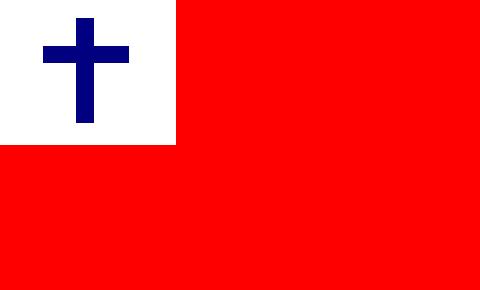 |
This flag represents a group of people,
not a country. |
The last flag I've designed for the uchronia I designed out of necessity, not from personal taste, because I needed to have such a flag.
With the fall of the Roman Empire, the numbers of Christians was greatly diminished, but not completely eradicated. The surviving Christians huddled together, fearing the Germanic and Thiazic tribes, and moved slowly from Italy into the Alps. They Christians adopted a red flag, for blood, both of Jesus and earlier Christians who died for their beliefs, with a white canton, for God, sporting a blue cross, for purity. In the past, the Christian flag was an extremely rare sight, but now as the Thiazic and German Confederations are becoming more tolerant, Christian missions flying their flag can be seen across Europe. The Ceppers, though, have retained their ancient suspicions of the Christians and today Thula island and the Kepperlands in North America and the British isles are one of the few places where dissident religions are still illegal. Nevertheless, there are small Christian populations scattered throughout the Kepperlands, but their numbers are so small they are nearly negligible.
If you're interested in flags, you may want to go over to Flags of the World, the largest site on the web devoted to vexillology. I have gotten all my "natural flags" pictures from those guys.
The six flags here as well as the two sets of coats of arms are my own creations. I created all of them with a mixture of pencil and pen and electronically using Microsoft Bitmap Editor. Use of these pictures is legal for non-commercial endeavors so long as you first contact me and get my approval in writing and post my name and a link back to my page wheresoever you use my flags. Thanks!
Z. H. Fordsmender
Atlanta, Georgia
2001
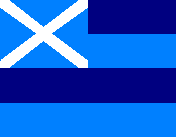
 My interest in flags is as old as my interest in languages and history, but perhaps not quite so passionate. I do, though, feel that it is only right ( :) ) for my uchronia people to represent themselves. The first flag I seriously designed was in 1999 and it stood to represent the Cepperjoleddic language (pictured at the left). The flag was simple: the traditional Cepper colors - blue on blue - with St Andrew's Cross in the canton in homage to Gaelic, to which the language owed many loans. Today, I represent the old Ceppers and Cepperjoleddic language communities with the Old Cepper Flag (pictured at the right). The Cepper people were the descendents of the Gaels and Gothic peoples who settled Thula Island (Iceland). To represent their watery way of life, and their dual-heritage, the Ceppers use a blue-on-blue bicolor. In the Anglo-Saxon conquest (late AD 800s), the Cepper flag splattered with blood was such a common sight that the conquest is called the Purple Wars.
My interest in flags is as old as my interest in languages and history, but perhaps not quite so passionate. I do, though, feel that it is only right ( :) ) for my uchronia people to represent themselves. The first flag I seriously designed was in 1999 and it stood to represent the Cepperjoleddic language (pictured at the left). The flag was simple: the traditional Cepper colors - blue on blue - with St Andrew's Cross in the canton in homage to Gaelic, to which the language owed many loans. Today, I represent the old Ceppers and Cepperjoleddic language communities with the Old Cepper Flag (pictured at the right). The Cepper people were the descendents of the Gaels and Gothic peoples who settled Thula Island (Iceland). To represent their watery way of life, and their dual-heritage, the Ceppers use a blue-on-blue bicolor. In the Anglo-Saxon conquest (late AD 800s), the Cepper flag splattered with blood was such a common sight that the conquest is called the Purple Wars.


